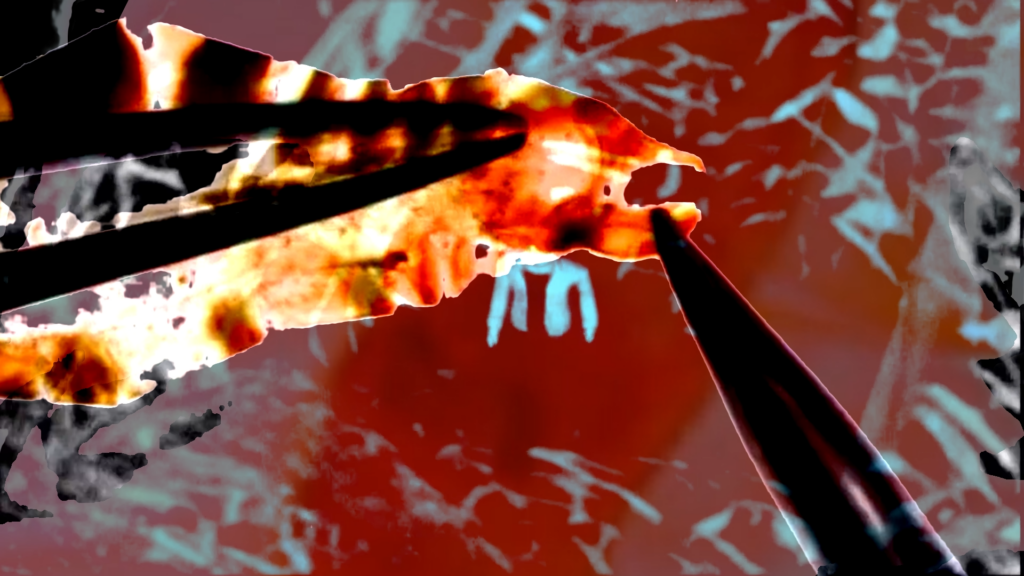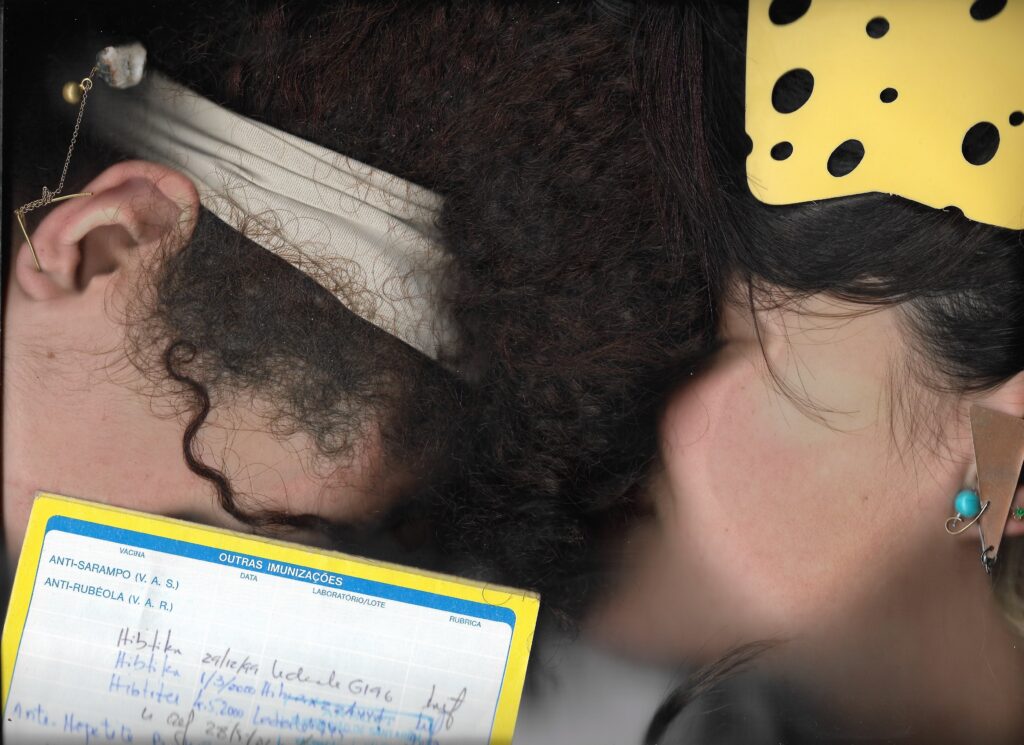On migration, kinship and (be)longings: Three meditations with cards | Daniella Valz Gen
Before you dive in: Daniella and Meenadchi have created a suggestive playlist ‘Land and heart’ alongside the commission, please listen while you read.
These meditations are formulated as an extension of my oracular practice which engages with speculative meaning-making and constructs narrative through the rhyming of visual patterns in relation to context and sensation, which could be termed intuition.
The first three questions were formulated as a response to the invite from performingborders and following an in person conversation with Alessandra Cianetti. They stem from a desire to reflect on ongoing issues that consider borders from a relational focus point, including our relationship with the land we occupy, interpersonal connections through differences and meeting points, and communication. In this context, borders are seen as personal boundaries, an acknowledgement of uniqueness, and as such they imply a capacity for self-awareness to ground ourselves in personal sovereignty as we navigate relationships within diasporic and migrant contexts.
The following meditations are interjected by comments from Meenadchi and responses from me. After this back and forth I asked Meenadchi if they had a question that I could reflect on with the cards as a clarifying point after the previous readings. The final question is proposed by them as a way to close the reflections.
I have found Meenadchi’s work on Decolonising Non-Violent Communication a fundamental framework. I first came across their work in 2018 and it has been an ongoing point of reference and discussion amongst my personal support networks. Throughout the last quarter of 2021, I revisited Meenadchi’s workbook as I felt I needed to re-ground my understandings after a series of relational challenges aggravated by the pandemic.
At this time, I also had the privilege to attend a Family Constellations session guided by Meenadchi. Witnessing this aspect of their work allowed me to see many parallels on our approaches, specifically when it comes to confronting an issue through the dynamics of chance by entering a time-space framework that is non-linear, something that occurs in divination with cards (and beyond) as well as during a Family Constellation.
I invited Meenadchi to be in dialogue with me throughout the process of mediating on the questions with the Tarot de Marseille, because I wanted to consider relational aspects alongside someone that was invested in a mindful and self-reflective approach towards communication within a decolonial framework. After having experienced Meenadchi’s Family Constellation work, I felt a deep resonance on another level still, with their practice and a further desire to connect through a divinatory approach. I have learned a lot from Meenadchi and I feel honoured that they accepted to engage with this work.
Meenadchi and Daniella had a conversation about the readings on Google Docs, where Meenadchi was able to respond via the comments function. We have translated these interventions and dialogue to our website using different colours to mark Meenadchi and Daniella’s comments. Meenadchi’s comments are in brown and Daniella’s are in ochre. We have highlighted the words/text that Meenadchi commented on in brown. All the comments made outside of the original reading are marked by […].
I. How can we honour the land we currently occupy while resisting assimilation into the dominant cultures that claim that land?
5 Batons The Emperor Knight of Batons
Queen of Batons at the cut
Noblet Flornoy
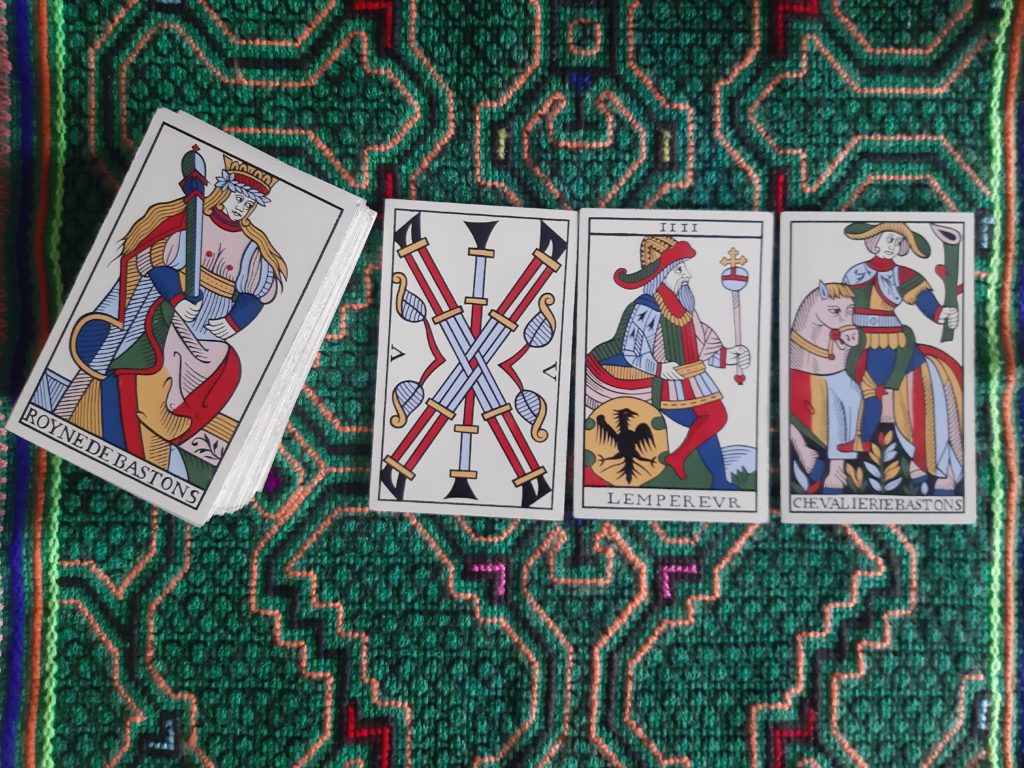
[Meenadchi: For the first time, it occurred to me why do we always talk about occupying land? As though the land does not occupy us. As though we are not made of the land. And I know this verbiage truly comes from the way we co-exist with the land, in saying that when co-existence is not in care or thoughtful reciprocity, it becomes an occupation. But it really has me thinking about surrender and reclamation. What if the land was always in control of how we move on/towards/within her?
Daniella: Thanks for bringing this up. Your comment resonates so much with me. Occupation and co-existence seem like a good juxtaposition, and this brings me to an ongoing enquiry for me around what it means to belong. I find language fails us, for belonging gets tangled up with references of property and rights of occupation. And though important to discuss, this is not the belonging I’m trying to learn. Rather an experience of being occupied by the land I’m in, feeling it seep into me in different ways. We could say the land determines a way of being within it, in a similar way, cultures determine ways of being. I believe we could start to delineate a very complex constellation on how we are influenced by our environments be them natural or cultural. And yet I wonder how we could get back to the simple fact of the land holding our bodies.This land or this land, regardless, it still holds and feeds. Perhaps that acknowledgement is what brings us to a caring and thoughtful reciprocity.
Meenadchi: The idea of land seeping into me is so sweet.]
Diaspora and migration cause us to hold within ourselves different allegiances, which on occasion can be conflicting with each other. This dynamic can stand in the way of us being able to access our own sense of rootedness and belonging, generating an underlying instability.
[Meenadchi: This feels so true. I feel curious about root systems. When and how do root systems uproot each other?
Daniella: This feels like a big question. I wonder that too. And also, what does it take to hold two different root systems and integrate them in a symbiotic way?
Meenadchi: I’m so curious about roots!!]
Defining a relationship on our own terms with the place where we live is important for various reasons: It can support us creating stability as it grounds us and allows us to cultivate an ethical and mutually supportive practice with our immediate environment, acknowledging our impact, and rooting us in ecological values. This can be a way for us to channel and express our desire for belonging, and also to honour the spaces that we come from and long for through our appreciation for that which is currently available to us, and the decision to minimise harm to our surroundings.
The question acknowledges the tension of remaining true to who we are and where we come from, while we accept and appreciate the environment we are currently in. The risk of assimilation is that it provides a script for us that could facilitate a perceived diminishing of conflict. By giving into assimilation, we avoid our authentic expressions in order to generate less discomfort around us by behaving in the ways of the dominant culture, yet this has a cost as it necessitates that we tone down, compromise or compartmentalise parts of ourselves.
[Meenadchi: I love this so much!
Daniella: <3]
Seeking a sense of stability and belonging through a diasporic and migrant experience calls us to explore the distance and tension between where we come from and where we are at with a desire to find harmony and turn that complexity into a generative context.
The cards that have shown up to anchor this meditation highlight our capacity for action when it comes to honouring the land without assimilating into the dominant cultures of that place. We have three spirited characters: The Queen of Batons on the left, The Emperor in the middle and the Knight of Batons on the right. This emphasis on embodied approaches comes as a welcome confirmation that we have a lot of agency when it comes to claiming our belonging.
The Queen of Batons at the cut tells us that it all begins by making a decision. They look at the cards ahead as assessing the job at hand, armed with the tool that helps create, and with a willingness to provoke and be seen. This queen’s attitude is supported by confidence. We do better when we are able to claim a creative approach towards honouring the land we occupy and come up with our own unique ways, not to dilute, blend or assimilate, but rather invent, exercise our cultures of origin and respond to what we are called to admire and appreciate from our current environments.
The 5 Batons showing up at the beginning of the line of cards evokes physical activity. If we think of the weave of batons as muscle tissue, and we look at the movement within the imagery of the card, star jumps emerge. The opening to the reading tells us that it takes physical work and effort to establish a direct bond with our environment and remain in integrity with our roots. We have to put in the work. As we do that work, we are told to hold on to our own sense of authority, as The Emperor signals, a forthright and explicit authority that when necessary is expressed towards others. We are claiming space and this requires a display of decisiveness. The Knight of Batons at the end of the line tells us that to sustain our creative effort and authority we need to move forward maintaining a motivated spirit, with a willingness to be seen.
[Meenadchi: This resonates tremendously. That life is evoked by making the decision, accessing agency. Following the decision, we take and make physical action. And finally the willingness to be seen. What awakens in me here is a sense of spirit, the remembering that when we are willing to be seen, we invite others to be seen as well. And then begin the questions of how do we see ourselves, because as we see ourselves is how we see others. And when we have been conditioned to see ourselves in XYorZ ways, what then? But to be seen as spirit and source and the land see us, that is something.
Daniella: Thank you so much for bringing up spirit. I think spirit is essential within relationship, is perhaps what keeps us in integrity and sparks our creative impulse to shape our bonds.
Meenadchi: Love the idea that spirit keeps us in integrity. That’s very nourishing.]
II. How do we intentionally build kinship through the space between each other?
Before pulling cards let’s clarify our understanding of kinship. Kin refers to a bond through connection and relationship. When we refer to someone as kin, a specific quality of relationship is implied, one that is ongoing, sustainable, stable: an accountable bond, one that is tangible and explicit. This is why it’s common to refer to blood relations as kin. The intention of this question is to think about kinship beyond the bonds of family, as well as shared culture and identity: Kinship as an enduring relationship through difference.
[Meenadchi: Love.]
It’s important to acknowledge that familial and cultural bonds set up a template, a sort of script for relationship that gets deeply ingrained through conditioning and inherited energetic patterns, and not necessarily one that supports a healthy bridge between individuals. It can often be a bridge propped up by obligation, denial of difference, and expectations. So the intention that the question refers to is one that subverts conditioned relational scripts to centre conscious awareness of self and other, an intention of dwelling in truth and showing up fully for contact with another person that is also willing and able to show up fully.
It’s been pointed out to me before that terms like “truth” and “showing up fully” can glaze over our complexities. These terms could be assumed to imply coherence and accessibility to all parts of ourselves at every moment. In my experience this is an idealised and flat view, and also impossible, and is certainly not what I imply when I refer to “truth” and “showing up fully”. For me, paradox is truth, showing up with our paradoxes and contradictions is showing up fully. And more so when it comes to relating.
Quite often our own internalised pressure to be coherent causes us to deceive ourselves and those we care about by denying the knotted tensions between the intersecting strands of emotion, desire and capacity that run through us. Showing up fully and dwelling in truth starts with access, awareness and acceptance of ourselves within our contradiction and unresolvedness.
[Meenadchi: What a big yes from my body. And how the naming of what needs naming creates ease in the system.
Daniella: I have found a deep relief and liberation in stepping away from the pressure to present a resolved and coherent stance.]
Let’s return to the question and pull some cards:
How do we intentionally build kinship through the space between each other?
4 Batons 9 Batons Knight of Coins
Page of Cups at the cut
Noblet Flornoy
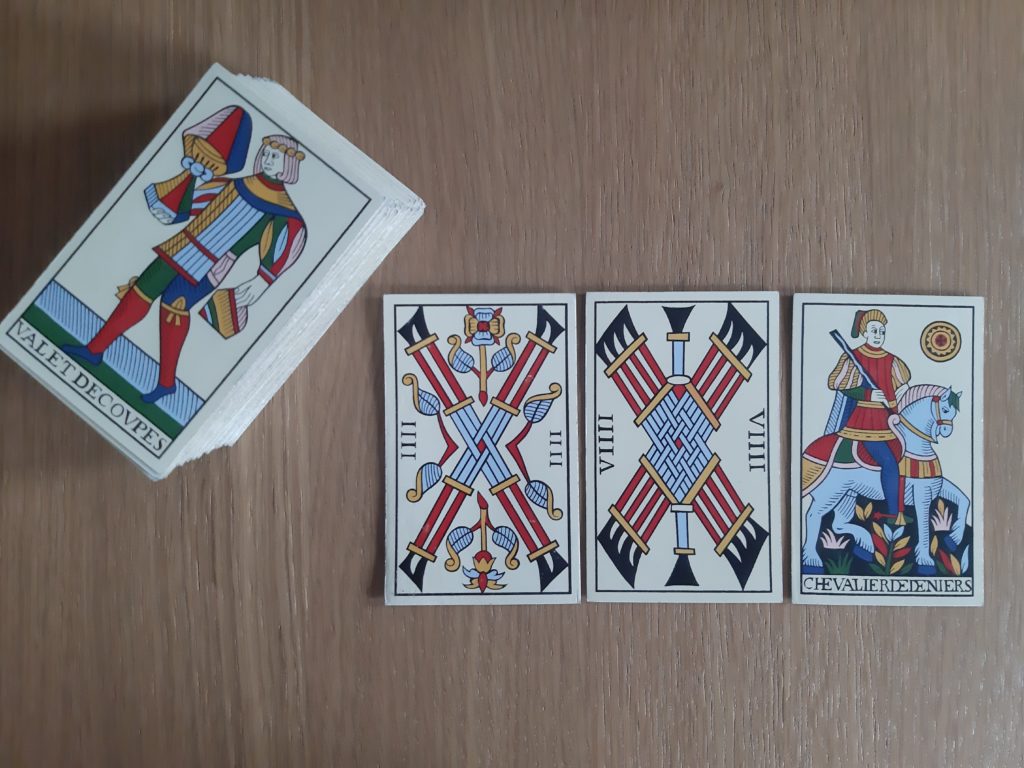
I’m happy to see the batons showing up as the question is centred around building. The batons are both strong and malleable, they allow us to create structures. The cards show us that it’s important to start from a firm and stable structure, the foundations of the 4 Batons allow for a quick strengthening to happen as we then jump to 9 Batons: a robust tapestry in progress, unfinished yet highly developed.
If we make sure that the basis for our relationships is supportive, then we achieve a strong bond.
As mentioned in the preamble to the question, the premise is that we depart from our individual and autonomous position in order to meet another and forge a bond with awareness and attention; “enmeshment” is the opposite of that, a pre-programed script, and it would be a mistaken reading of the imagery of the woven tapestry that the batons evoke, for enmeshment does not allow authentic contact.
Let’s dwell on the imagery of batons on this card pull a little longer. We see that the intertwining required for building necessitates touch, and a strong woven structure also needs tension. The care that informs the laying out of the initial foundations (4 Batons) is an essential component, and it’s important to acknowledge it as such, as it’s testimony of the intentionality within the bonds that we are investing in, their backbone, their integrity.
The triad of intention, touch and tension implies intimacy, and therefore risk. There’s an erotics (in the Audre Lorde use) here. Building kinship demands an ability to have close contact and to exercise our relational erotic energy in an understanding that it is an ongoing process.
Let’s look at the two characters that flank the Batons: The Page of Cups on the left is the image of someone that brings forth the emotional component and the openness required to share of themselves, take in the other, and learn about them rather than assume. This attitude is the foundation of building kinship, a principle in constant renewal. The Knight of Coins tells us that as we move forward in the strengthening of a bond, we do so through an investment of energy and an expression of value of the other in tangible ways. We do not take for granted our kin, on the contrary, we appreciate and give to them.
III. How can we best communicate between us through different languages and ways of being in the world?
7 Batons 4 Coins 6 Coins
7 Cups at the cut
Noblet Flornoy
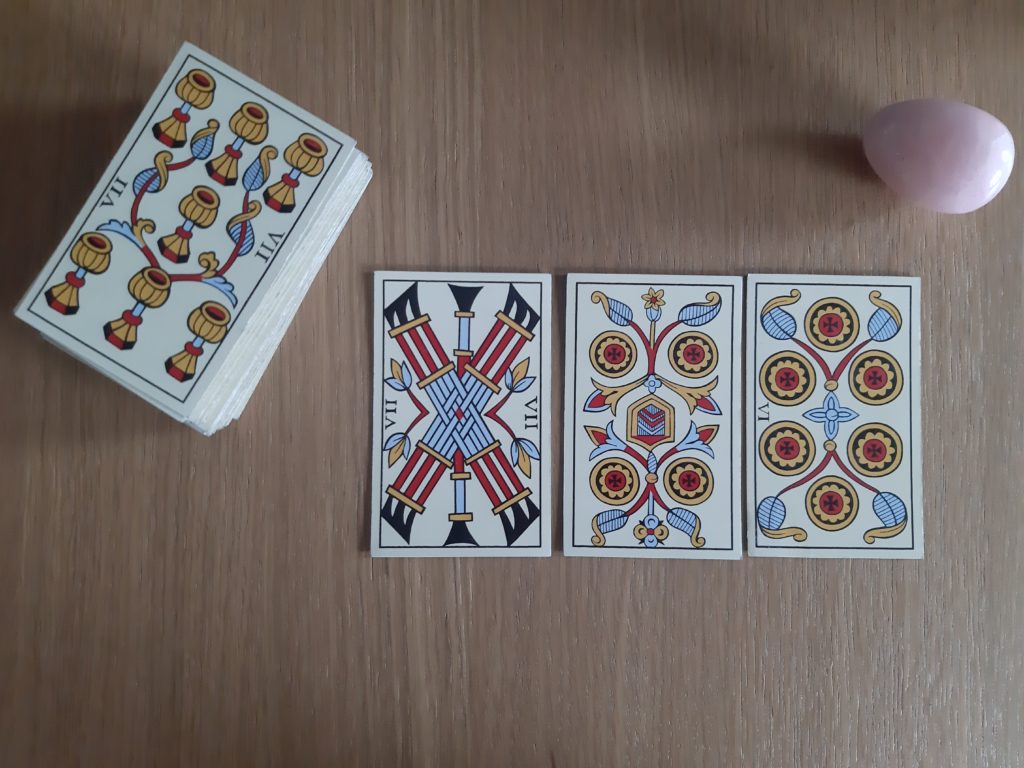
The cards start by pointing towards the clarifying process, individual and internal, that happens before having an intentional conversation with another. Overall this pull seems to speak back to us and say: You want to know how best to communicate with another through difference? Start with yourself: What is it that you really want to say? Why are you saying it to this person? What is your purpose? How can you enter a stable and reciprocal exchange?
It’s interesting that upon enquiring about communication through difference, what’s reflected back is not centred on said difference as an external factor, but rather on the sorting of the various discerning aspects of that which needs to be communicated and on the quality of exchange as such.
When 7 Cups show up I’m always drawn to the middle cup, concealed and guarded off through the garlands, singled out from the rest of the cups. This image often evokes for me the sensation that there’s a somewhat challenging emotion that due to its nature struggles to find its place amongst the others. Perhaps it is something that one might struggle to acknowledge, whether it is about ourselves or about the relationship as such.
The departure point of the question is not one of shared ground, but of difference, and this acknowledgement in and of itself can make us aware of how we struggle to communicate that which seems deeply personal. It’s important to highlight that the difference alluded to in the question is not just of language, culture, positionality or identity, but rather the very fact that in spite of what we might perceive as shared ground, we each hold an individual configuration of meaning-making strategies. Returning to the 7 Cups, I’m reminded of the times in which I’ve felt alone in a feeling or a meaning (‘this is particularly sensitive for me because of who I am’) and assumed that no one else could understand where I was coming from.
Jumping from 7 Cups to 7 Batons takes this anxiety to another plane: This personal sensitivity then is experienced as a relational ripple. Notice the seventh baton in the middle of the card creating a little bump underneath the woven fabric of the other six, a point of discomfort, of unease, a disruption to the illusion of flow.
And yet, 4 Coins reiterate the importance of the stable foundation, a reminder that we build relationships on the basis of shared values, that in spite of discomfort, we are constantly returning to our connections as a worthy pursuit. 6 Coins conclude the string of cards, illustrating that the intention and ongoing practice of reciprocity as a symmetrical flow evens things out after the ripples and tensions created by difference in understandings between us. As we trust in the reciprocal nature of our exchanges, and prepare to communicate through difference, communication can follow and flow from there on.
[Meenadchi: Inquiries that emerge for me are with whom do we believe we can exist in reciprocity. And that being in reciprocity requires having a sense of agency. Feeling like I can give and receive, decline and invite. Reciprocity cannot exist where there is a sense of forced pressure and the sense of pressure is always mitigated by our own sense of agency. Thank you for these beautiful thoughts.
Daniella: I agree so much with this question. Discerning who we want to invest in a reciprocal relationship with is essential, as is assessing whether the conditions for reciprocity are available in such relationship. Another question that emerges is what do we do with the sense of forced pressure and how can we have access to more agency and discernment?]
Meenadchi – The question that is coming is:
IV: Where do agency and surrender meet? Agency being the part of us that is driven to action and surrender being the part of us that can rest in flow.
Ace of Coins 4 Batons 4 Swords
Force at the cut
Noblet Flornoy
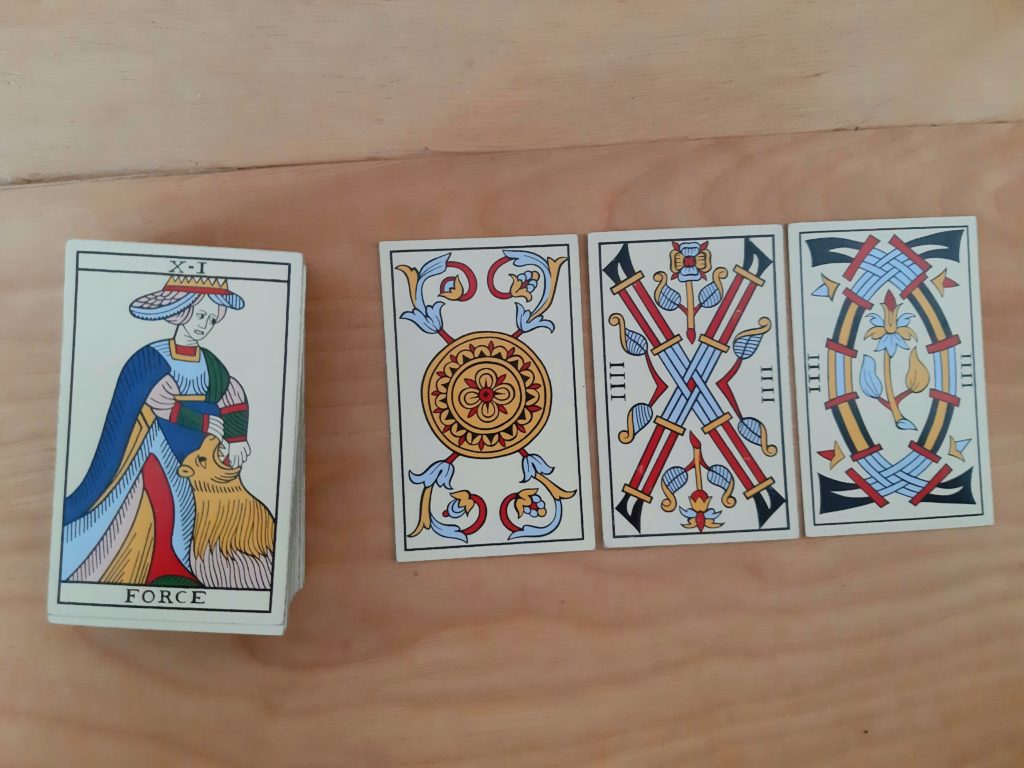
We might be tempted to force things, to seek to control situations, circumstances, people, and even parts of ourselves, as we see in the dynamic illustrated in the Force card. We might seek to feed a hunger fuelled by our desire for change, to reap the rewards, swallow them whole as a golden nugget, a prize for the work we do (Ace of Coins). This dynamic is part of the meeting point between agency and surrender. It is not free of conflict or discomfort. It requires that we acknowledge that our drive for action and our capacity to surrender to flow creates a tension within us and with our contexts.
With 4 Batons and 4 Swords the cards show both agency and surrender as requiring stability and structure. The 4 Batons in the middle show up for the second time throughout these meditations, and remind us that enduring actions require strong foundations. With the Batons we create and build, this implies movement. As I look at the image of the 4 Batons crisscrossing, I think of the skill of lighting up a lasting fire. The balanced arrangement of logs and kindling is fundamental to sustain the burning at a desired speed: How do we determine the right time to add a fresh log? The fire should be burning enough still to make sure that the wood catches before needing to revive it with kindling. Timing is important because if we delay our action we waste more resources than we need to in the end. Agency in this context comes through as considered and skillful action.
Surrender also presents itself as a stable container with the strong structure of the 4 Swords: a clear demarcation of barriers in order to protect the integrity of what is inside.
The rhyming of 4 Batons and 4 Swords demonstrates that action and rest, agency and surrender, occur at the same rate, they match each other. We are called to understand that proportion as a meeting point between them. Surrender follows agency in an acknowledgement of balance, and a relinquishing of control.
Postscript
After I do a tarot reading for a querent I remind them that what comes up through a meditation with the cards has many layers compacted in one moment or in one text. As I read the texts above I recognise the density that is packed up in a few lines. It’s my wish that these meditations that can seem simple at first unfold their richness over time through being revisited.
Daniella Valz Gen is a poet, artist and card reader, born in Lima, Peru and based in London. Their work explores the interstices between languages, cultures and value systems with an emphasis on embodiment and ritual, through the mediums of performance, installation, conversation and text.
Valz Gen is the author of the poetry collection Subversive Economies (PSS 2018). Their prose has been published in various art and literary journals such as Lish, SALT. Magazine, Paperwork Magazine and The Happy Hypocrite amongst others. They’re currently developing the next stage of their project (be)longing, a series of immersive elemental rituals.
Valz Gen has been focusing the last two years on integrating their oracular practice with their art and poetry. They run monthly gatherings exploring poetics in relation to the symbolism of Tarot cards within the container of Sacred Song Tarot. Instagram: @daniella_vg | @sacredsongtarot
Meenadchi (pronouns: Meenadchi/they) is a facilitator and somatic practitioner whose work centers the softness of meeting our best self and deepening into our collective light. Using a blend of family constellation therapy and Non-Violent Communication, Meenadchi weaves group containers in which participants are invited to recognize and heal the entanglements of bad communication and ancestral trauma so that we can collaboratively become a set of bad-ass ancestors who nurture legacies of connection and joy – both for ourselves and the communities we love to serve. traumainformednvc.com
This commission is a part of the performingborders 2022 programme, supported by Arts Council England and Necessity Fund.
Image credits: Daniella Valz Gen. Courtesy of the Artist.

